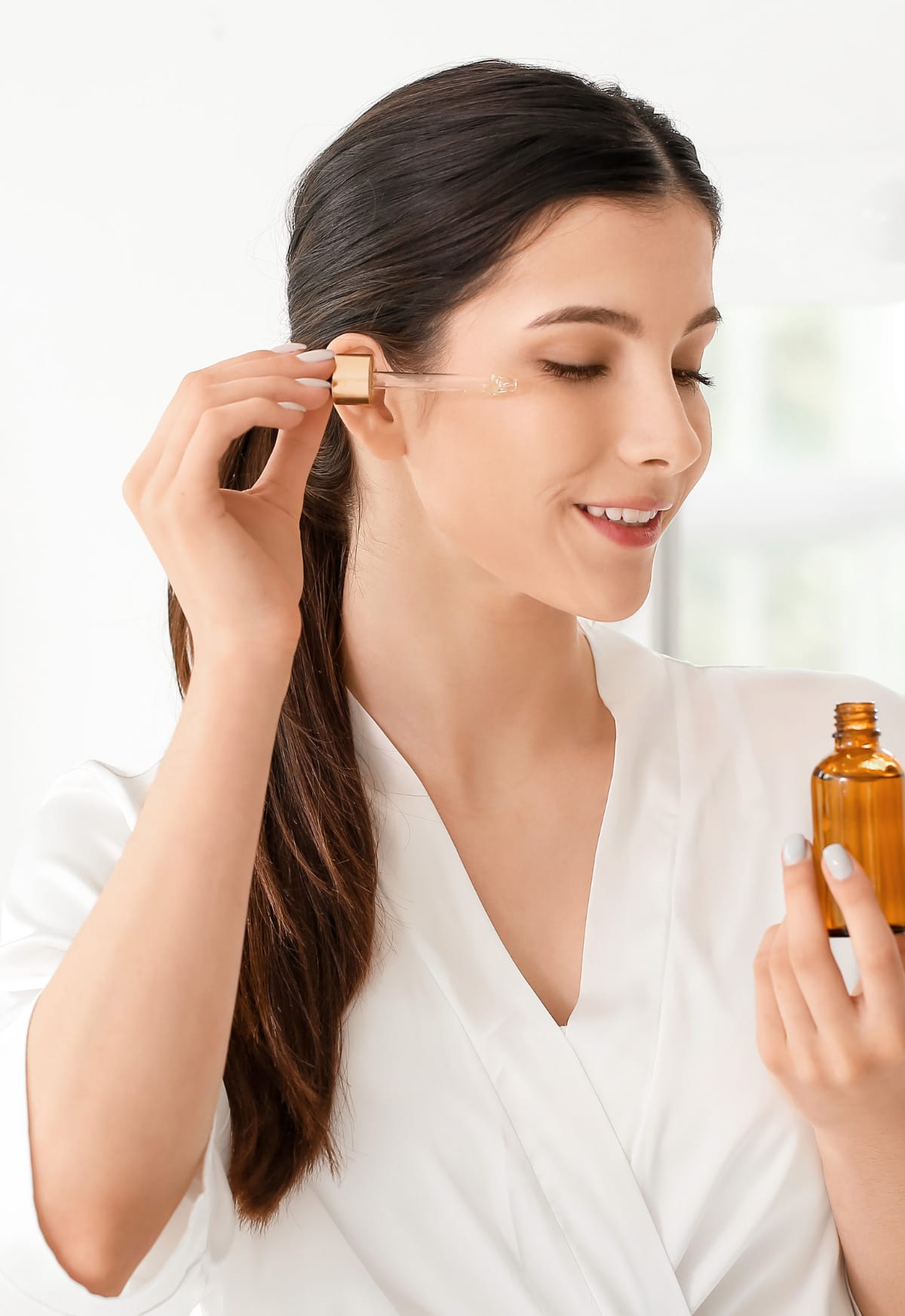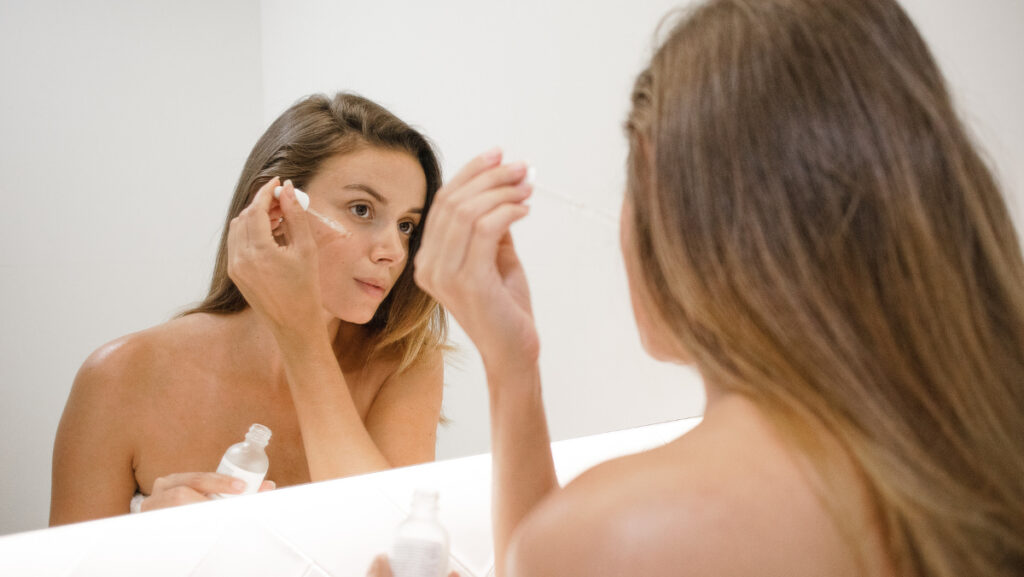
In the ever-evolving world of skincare, the pursuit of practical solutions for clear and healthy skin remains a top priority. Countless products have likely crossed your path, each promising transformative results.
But amid the sea of options, a question emerges: Can azelaic acid and tretinoin, two potent ingredients with distinct capabilities, work in tandem to unlock your skin’s full potential?
Azelaic acid’s rise isn’t mere trendiness; it’s a devoted ally for sensitive, acne-prone skin. As for tretinoin, it is the dermatologists’ best friend for tackling acne and aging.
Together, they form a potential powerhouse combination. This partnership might hold the key to addressing a spectrum of skin concerns. The true intrigue lies in uncovering whether this dynamic duo can truly harmonize to elevate your skincare regimen and reveal a radiant canvas.
Are you ready to find out whether you can combine azelaic acid and tretinoin? Read on to learn more about these ingredients and their synergistic effects for a radiant complexion!
What Is Azelaic Acid?
Before I reveal my cards about combining azelaic acid and tretinoin, I will make you an expert on what each ingredient has to offer separately.
Let’s dive into the skincare world and unfold the beauty of azelaic acid. It’s a naturally occurring substance found in grains like wheat, rye, and barley. This pinnacle of skincare magic has multiple benefits for your skin, especially if you’re battling acne or rosacea.
It is also a product of the yeast that resides on human skin, emphasizing its close affinity with the body’s natural processes.
Although we commonly encounter azelaic acid in skincare products, it’s essential to note that the version used is often synthetic, harnessed to harness its potent benefits.
While there’s a multitude of skin care products nowadays, not all manage to offer the varied effectiveness and gentleness of Azelaic Acid.
The mild nature of Azelaic Acid allows it to work effectively on any skin type without causing harsh reactions. Nevertheless, always conduct a patch test to ensure your skin doesn’t react unfavorably.

Benefits Of Azelaic Acid For The Skin
Azelaic acid functions as a guardian for your skin’s health and radiance, offering a range of benefits that make it a cherished ingredient in skincare formulations.
One of its prime talents is performing a deep cleansing ritual on the skin. It acts as a keratolytic agent, gently sloughing away dead skin cells that often contribute to the formation of blemishes, blackheads, and other imperfections.
This exfoliating prowess promotes skin cell turnover, unveiling a fresher and rejuvenated complexion.
However, azelaic acid’s offerings extend beyond exfoliation. It showcases notable anti-inflammatory capabilities, quelling redness and reducing the swelling often accompanying blemishes.
As a multitasking wonder, it carries the mantle of an antioxidant, antimicrobial agent, and brightening powerhouse. These attributes make it an appealing choice for skin conditions, including acne, rosacea, and hyperpigmentation.
Quick Summary of Azelaic Acid’s Benefits:
- Reduction of Inflammation: Azelaic acid’s anti-inflammatory properties can help alleviate redness and irritation linked to acne and rosacea.
- Acne Management: It targets and eliminates acne-causing bacteria on the skin’s surface, curbing the likelihood of breakouts.
- Exfoliation and Pore Clearing: With its exfoliating properties, it unclogs pores and rids the skin of dead cells.
- Lightening of Dark Spots: Azelaic acid is a formidable opponent against dark spots and uneven skin tone, particularly beneficial for post-inflammatory hyperpigmentation.
How To Use Azelaic Acid
Integrating new active ingredients into your routine can be daunting at first. Here is a complete step-by-step guide on how to use azelaic acid like a skincare guru:
- Patch Test: Before using azelaic acid on your face, perform a patch test on a small skin area, preferably on your forearm. Apply a small amount of the product and observe for any adverse reactions, such as redness, itching, or irritation. This helps ensure your skin tolerates this ingredient.
- Choose the Right Product: Azelaic acid can be found in various formulations, including creams, gels, and serums. Select a product that suits your skin type and concerns. It’s also advisable to start with a product containing a lower concentration of azelaic acid to minimize the risk of irritation.
- Frequency: Begin using azelaic acid once every other day or every few days, especially if your skin is not accustomed to active ingredients. Gradually increase the frequency as your skin becomes more accustomed to it.
- Cleansing: Cleanse your face using a gentle cleanser to ensure your skin is free from impurities before applying azelaic acid.
- Application: After cleansing and toning, apply a thin layer of azelaic acid to your face. You can use your fingers or a clean applicator to spread the product evenly. Avoid applying it near the eyes, nostrils, and mouth.
- Wait Time: Allow the azelaic acid to fully absorb into your skin before proceeding with the rest of your routine. This usually takes a few minutes.
- Follow with Moisturizer: Apply a moisturizer to lock in hydration and create a protective barrier on your skin. This step helps minimize potential irritation and dryness caused by the active ingredient.
- Sunscreen: Apply a broad-spectrum sunscreen with at least SPF 30 in the morning, even on cloudy days. Azelaic acid can make your skin more sensitive to the sun, so protecting your skin from UV rays is essential.
- Night or Day Use: Depending on your routine and the product’s recommendations, you can incorporate azelaic acid either in the morning or evening. If using it in the morning, make sure to follow up with sunscreen.
- Observation: As you integrate azelaic acid into your routine, pay attention to how your skin reacts. Some mild tingling, redness, or peeling might occur initially, but these symptoms should subside as your skin adapts.
What Is Tretinoin?
Now, let’s switch gears and unravel the secrets of tretinoin. Tretinoin is a prescribed-only derivative of vitamin A and a potent ally in your skincare routine. It’s a retinoid that dermatologists have trusted for decades.
Why? Well, it’s been proven to improve acne, photoaged skin, and other pesky skin conditions, helping you feel more confident daily.
Tretinoin’s effectiveness lies in its ability to speed up skin cell turnover. This means it helps your skin “shed” old skin cells faster and prompts the growth of fresh, new cells. With regular use, you’ll notice fewer wrinkles, less acne, and an overall smoother appearance.
You might associate skin shedding with dryness and irritation but don’t worry. Though these can be initial side effects, your skin usually grows accustomed to tretinoin over time.
For the best results, you’ll want to use tretinoin consistently. However, be ready to be patient. Significant improvements typically occur over several months, so it’s a long game, but the results are worth it.
Benefits Of Tretinoin For The Skin
Tretinoin boasts a repertoire of remarkable effects contributing to its esteemed skincare position. Primarily, it acts as a master architect for the skin, replacing fragile and thinned outer layers with a fortified epidermis.
This renewal process imparts renewed vitality and resilience to the skin’s surface, fostering a healthier and more vibrant appearance.
Furthermore, tretinoin addresses uneven skin tone caused by factors like actinic keratoses – small, uneven patches resulting from sun exposure.
Its targeted action on these imperfections results in a refined and smoother skin texture, akin to an artist fine-tuning a canvas.
The brightening capability of tretinoin emerges as it harmonizes melanin granules, leading to a more even and balanced skin tone.
This effect is particularly beneficial in combating hyperpigmentation and achieving a radiant complexion.
Tretinoin also plays a pivotal role in collagen production, a crucial protein responsible for skin structure and elasticity.
By sparking the creation of new collagen in the papillary dermis, it enhances skin firmness, reducing wrinkles and fine lines.
In addition to these benefits, tretinoin conducts an exfoliation symphony. By unclogging pores and promoting the growth of new cells, it fosters smoother and clearer skin with improved texture.
Let’s summarize the benefits of tretinoin for the skin:
- Skin Renewal: Tretinoin replaces atrophic skin with a fortified epidermis, infusing vitality, and resilience.
- Even Skin Tone: Tretinoin targets sun-induced patches like actinic keratoses, refining texture.
- Brightening Effect: By harmonizing melanin granules, tretinoin evens skin tone, radiating luminosity.
- Collagen Enrichment: Tretinoin ignites collagen production, enhancing skin firmness and diminishing wrinkles.
- Increased Cell Turnover: Tretinoin orchestrates exfoliation, unclogs pores, and fosters vibrant new cell growth.
How To Use Tretinoin
Introducing tretinoin into your skincare regimen involves a strategic approach. Commence with a dermatologist consultation to determine the appropriate concentration and usage.
No matter the concentration or potency, you will always need a prescription for tretinoin. Tretinoin comes in different formulations in concentrations that range from 0.01% to 0.1%.
Here’s a quick breakdown of how it is typically used:
| Strength | Recommended Usage |
| – 0.025% | Beginners or those with sensitive skin |
| – 0.05% | Intermediate users |
| – 0.1% | Advanced users or those with resistant skin |
Typically, tretinoin is integrated into the evening routine, allowing its transformative effects to unfold overnight.
Should you choose to also wear tretinoin in the morning, you need to know that it increases the skin’s photosensitivity.
Studies also suggest that tretinoin degrades when exposed to light. So, make sure to partner tretinoin with robust sun protection.
Start with a modest amount applied to the entire face, gradually increasing frequency as your skin adapts. Embrace the patience required, as initial redness or peeling may occur, signaling the path to radiant results.
| Benefits of Azelaic Acid | Benefits of Tretinoin |
| – Controls inflammation and redness | – Smoothens skin texture |
| – Combats acne | – Stimulates collagen production |
| – Brightens the skin | – Reduces wrinkles |
Is Azelaic Acid And Tretinoin A Good Combination?
Azelaic acid and tretinoin are two ingredients that make waves in the skincare industry right now. Both these components hold a powerful punch when it comes to promoting healthier and youthful-looking skin in their own way.
What if you want to combine the benefits of azelaic acid and tretinoin in the same routine? Will it be a good combo, like PB and jam, or cause an unpleasant chemical reaction?
You can rejoice because you can effectively combine these active ingredients. Let’s dive in and explore what makes azelaic acid and tretinoin a highly effective pairing in skincare:
- Azelaic Acid exfoliates the outer protein layer of skin cells, allowing other ingredients like tretinoin to penetrate more effectively.
- Tretinoin, known for its mild irritation, becomes easier on the skin as Azelaic Acid helps soothe potential inflammation.
- The combination of both ingredients amplifies the benefits of each other, potentially reducing the appearance of acne, pigmentation, and signs of aging.
Together, azelaic acid and tretinoin create a formidable team for skin care. If your skin concerns include acne, wrinkles, and uneven skin tone, this duo could potentially be part of your solution.
- Acne-Fighting Power: Azelaic acid and tretinoin work hand in hand to combat acne. While azelaic acid helps to reduce inflammation and regulate sebum production, tretinoin unclogs pores and prevents new breakouts. Together, they create a formidable defense against acne-causing bacteria, resulting in clearer and smoother skin.
- Brightening and Even Skin Tone: When addressing hyperpigmentation, combining azelaic acid and tretinoin can be a game-changer. Azelaic acid fades existing dark spots, while tretinoin promotes cellular turnover and prevents the formation of new pigmentation. This potent combination can lead to a more radiant and even complexion.
Remember, however, that skincare isn’t a one-size-fits-all solution. What works incredibly for some might not yield equally impressive results for others. It’s always crucial to listen to your skin and customize your regimen according to its unique needs.
It is also advisable to consult a dermatologist to ensure that the azelaic acid and tretinoin combo is suitable for your skin type and beneficial to your skin concerns.
Azelaic Acid And Tretinoin Combo Side Effects
While azelaic acid and tretinoin offer remarkable benefits, it’s important to be aware of potential side effects and take necessary precautions. Here are some considerations to keep in mind:
- Skin Irritation: Both azelaic acid and tretinoin can cause skin irritation, especially when used in high concentrations or if your skin is sensitive. Monitoring your skin’s response and adjusting the frequency or concentration accordingly is crucial. If you experience persistent redness, dryness, or discomfort, consult a dermatologist.
- Sun Sensitivity: Tretinoin, in particular, can increase the skin’s sensitivity to the sun. It’s crucial to apply broad-spectrum sunscreen with an SPF of 30 or higher during the day and limit sun exposure to minimize the risk of sunburn and further damage.
- Dryness and Peeling: Tretinoin is known to cause initial dryness and peeling as it accelerates skin cell turnover. To combat this, ensure you moisturize your skin adequately and consider using a gentle hydrating cleanser to avoid further drying out your skin.
- Discontinue Other Active Ingredients: When incorporating azelaic acid and tretinoin into your skincare routine, it’s advisable to discontinue the use of other potent active ingredients, such as exfoliants or strong acids. This will help prevent excessive irritation and allow your skin to adjust to the new regimen.

How To Use Azelaic Acid And Tretinoin For Radiant Skin
Now that we know that azelaic acid and tretinoin make a harmonious couple, we are steps away from reaping their combined benefits. Let’s uncover how you can use azelaic acid and tretinoin in the same routine for maximum effectiveness.
Use One Ingredient At A Time
Prioritize caution and patience when introducing new elements to your skincare routine. Start by incorporating each ingredient separately to assess how your skin reacts to them.
Initiate your journey by initially adding azelaic acid or tretinoin to your routine. This step allows your skin to adjust gradually without overwhelming it.
Once your skin has acclimated to one ingredient, introduce the other. Slowly integrating both ingredients prevents potential irritation or adverse reactions.
Use Azelaic Acid In The Morning And Tretinoin At Night
Azelaic acid shines in your morning routine. Its anti-inflammatory and brightening qualities offer a refreshing start to the day. Apply after cleansing and before moisturizing, ensuring a protective layer against environmental stressors.
Reserve your evening routine for tretinoin. Its resurfacing benefits, including improved skin texture and reduced wrinkles, make it an ideal companion for overnight restoration. Use a pea-sized amount on cleansed, dry skin before moisturizing.
Always remember that patience and consistency are key when it comes to skincare. Results might not show up instantaneously, but long-term, steady application of Azelaic Acid and Tretinoin will likely lead you to the results you’re after.
PS: It’s always recommended to use SPF during the day while using these products, as these ingredients can make your skin more sensitive to sun exposure.
Conclusion: Unleash the Power of Azelaic Acid and Tretinoin
We’ve embarked on a revealing journey, traversing the powerful benefits of azelaic acid and tretinoin for your skin. It’s now clear why these two components together make an unbeatable skincare duo.
Here is a quick recap of what you have learned in this article:
The wealth of benefits of azelaic acid is staggering. From evening skin tone and reducing acne spots to combatting other common skin issues like rosacea, it’s an all-in-one solution.
You’ll also find it to be gentle on the skin, making it perfect even for sensitive skin types. The effects are not just on the surface but deep-seated, revitalizing and nourishing your skin from within.
Partnered with tretinoin, the effects of azelaic are further potentiated. This means quicker, more visible results. Tretinoin brings its own set of strong points to the table. You’ll appreciate how effectively it handles acne and wrinkles.
The added advantage is boosted regeneration for your skin. With tretinoin, you’re pushing your skin towards a healthier, more youthful look.
It’s important to remember that as powerful as this duo is, it’s not an overnight miracle. Consistent, regular use is key to achieving your desired results.
In the realm of skincare, the azelaic acid and tretinoin power duo is a game-changer. With these two in your skincare arsenal, you’re well on your way to achieving your skin goals. It’s your turn to experience the unbeatable benefits!
Beautymone is committed to providing you with comprehensive information on beauty, skincare ingredients, and more. Explore our articles on niacinamide and tretinoin, tretinoin vs. retinol, azelaic acid vs. salicylic acid, and azelaic acid and retinol to expand your knowledge and make informed decisions for your skincare journey.
Read the final part of this article, where we discuss some frequently asked questions and additional tips for incorporating azelaic acid and tretinoin into your beauty routine.
Frequently Asked Questions
